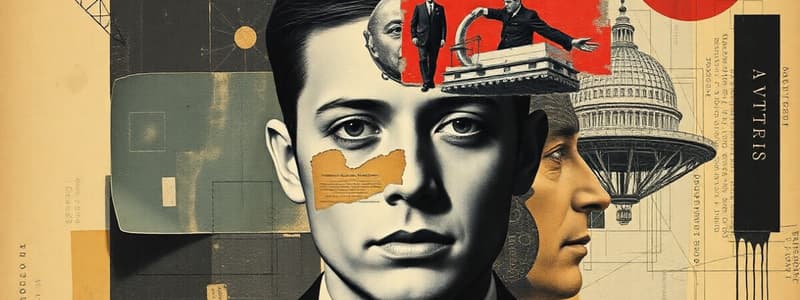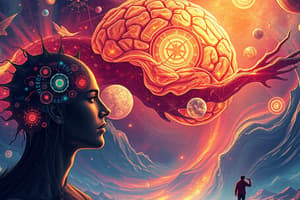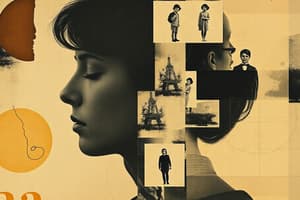Podcast
Questions and Answers
What is the general definition of cognitive theories of emotion?
What is the general definition of cognitive theories of emotion?
Cognitive theories of emotion suggest that our emotions are influenced by thoughts, beliefs, and interpretations of situations.
The James-Lange theory suggests that emotions are purely cognitive processes.
The James-Lange theory suggests that emotions are purely cognitive processes.
False (B)
Which of the following is NOT a key component of the James-Lange theory?
Which of the following is NOT a key component of the James-Lange theory?
- Cognitive appraisal (correct)
- Perception of physiological responses
- Emotional stimulus
- Physiological arousal
The Cannon-Bard theory posits that emotions and physiological responses occur simultaneously, but independently.
The Cannon-Bard theory posits that emotions and physiological responses occur simultaneously, but independently.
The Lazarus theory suggests that emotions are inherently determined by situations themselves.
The Lazarus theory suggests that emotions are inherently determined by situations themselves.
According to the Schachter-Singer theory, what plays a crucial role in determining the specific emotion experienced?
According to the Schachter-Singer theory, what plays a crucial role in determining the specific emotion experienced?
What is the main idea behind the use of cognitive restructuring techniques?
What is the main idea behind the use of cognitive restructuring techniques?
Flashcards
Cognitive Theories of Emotion
Cognitive Theories of Emotion
These theories emphasize that emotions are influenced by our thoughts, beliefs, and interpretations of situations.
James-Lange Theory
James-Lange Theory
This theory states that emotions arise from physiological reactions to events. We feel sad because we cry, not the other way around.
Physiological Arousal
Physiological Arousal
This refers to bodily changes like increased heart rate, sweating, or trembling that occur in response to a stimulus.
Cannon-Bard Theory
Cannon-Bard Theory
Signup and view all the flashcards
Lazarus's Theory of Emotions
Lazarus's Theory of Emotions
Signup and view all the flashcards
Cognitive Appraisal
Cognitive Appraisal
Signup and view all the flashcards
Secondary Appraisal
Secondary Appraisal
Signup and view all the flashcards
Schachter-Singer Theory
Schachter-Singer Theory
Signup and view all the flashcards
Misattribution of Arousal
Misattribution of Arousal
Signup and view all the flashcards
Emotional Stimulus
Emotional Stimulus
Signup and view all the flashcards
Emotional Intelligence
Emotional Intelligence
Signup and view all the flashcards
Cognitive Behavioral Therapy (CBT)
Cognitive Behavioral Therapy (CBT)
Signup and view all the flashcards
Solution-Based Brief Therapy
Solution-Based Brief Therapy
Signup and view all the flashcards
Miracle Question
Miracle Question
Signup and view all the flashcards
Scaling
Scaling
Signup and view all the flashcards
Externalization
Externalization
Signup and view all the flashcards
Competence
Competence
Signup and view all the flashcards
Exceptions
Exceptions
Signup and view all the flashcards
Positive Language
Positive Language
Signup and view all the flashcards
Client Initiative
Client Initiative
Signup and view all the flashcards
Therapeutic Process
Therapeutic Process
Signup and view all the flashcards
Systemic Therapy
Systemic Therapy
Signup and view all the flashcards
Demand-Oriented Therapy
Demand-Oriented Therapy
Signup and view all the flashcards
Identity and Its Building Blocks
Identity and Its Building Blocks
Signup and view all the flashcards
Narrative Therapy
Narrative Therapy
Signup and view all the flashcards
Language and Meaning
Language and Meaning
Signup and view all the flashcards
Objectivity vs. Subjectivity
Objectivity vs. Subjectivity
Signup and view all the flashcards
Dialogue as the Core
Dialogue as the Core
Signup and view all the flashcards
Therapist as a Guide
Therapist as a Guide
Signup and view all the flashcards
Relapses and Management
Relapses and Management
Signup and view all the flashcards
Study Notes
Introduction to Emotions and Cognition
- Cognitive theories of emotion suggest emotions are impacted by thoughts, beliefs, and how situations are interpreted
- These theories are not just about events causing emotions, but the perception and evaluation of those events
- Emotions are shaped by how we interpret situations, using mental processes like perception, memory, and reasoning
Historical Perspective
- Early emotion theories include James-Lange theory and Cannon-Bard theory
- Later, cognitive theories such as Schachter-Singer two-factor theory emerged
James-Lange Theory
- One of the earliest theories on emotion and its connection to physiological response
- Developed independently by psychologist William James and physiologist Carl Lange
- Argues that emotions result from physiological reactions to events in the environment
- A stimulus triggers physiological arousal (e.g., heart pounding) then the interpretation of this arousal is a specific emotion
James-Lange theory sequence
- Emotional stimulus
- Physiological arousal
- Perception of physiological responses
- Emotional Experience
James-Lange theory Example
- Seeing a bear (stimulus)
- Heart pounds, trembles, runs (physiological arousal)
- Perceives physical responses (perception)
- Experiences fear (emotional experience)
Cannon-Bard Theory
- An alternative to the James-Lange theory
- Suggests emotions and physiological responses occur simultaneously and independently in response to a stimulus
- Emotional experiences and physiological reactions happen at the same time but separately
Cannon-Bard Theory Diagram
- Emotional stimulus
- Emotional response
- Physiological response
Cannon-Bard Theory Example in Diagram
- Seeing a bear (stimulus)
- Feeling fear (emotional response)
- Heart pounds, runs (physiological response)
Cognitive Processes in Emotions
- Selective attention to emotional stimuli
- Linking memory to emotions
- Emotional intelligence, with the ability to perceive, understand, act, and manage emotions in oneself and others
Lazarus Theory of Emotions
- Emotions are determined by the appraisal of a situation
- Appraisal is how we interpret the situation, not the situation itself
- Cognitive appraisal plays a crucial role in emotional experience
Lazarus theory of Emotions Diagram
- Cognitive appraisal (primary and secondary)
- Emotional response
Schachter-Singer Theory of Emotions
- Emotions are a result of both physiological arousal and cognitive interpretation of that arousal
- Physiological arousal is not specific to one emotion, but the way it is interpreted determines the felt emotion
Schachter-Singer theory of Emotions Diagram
- Physiological arousal
- Cognitive interpretation
- Emotional experience
Cognitive Labeling
- Emotions are labeled based on cognitive interpretation of external cues
Misattribution of Arousal
- People can misidentify the cause of their physiological arousal
Other concepts from the text.
- Methods used in therapy
- Basic principles of therapy
- Further theoretical concepts
- Key figures mentioned in the notes.
Studying That Suits You
Use AI to generate personalized quizzes and flashcards to suit your learning preferences.




